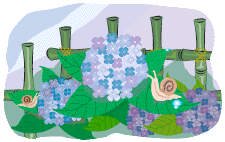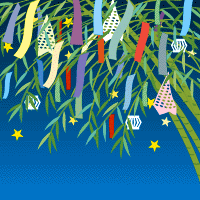Dear friends,
Sorry for not having written a letter last month.
We plant rice in May in Shikoku, and I also planted rice. It was a lot of fun but I was a little tired.
Murder cases by teenagers happened in succession last month. In one of them the murderer, reportedly, said that he was eager to experience murder and that he wanted to know how he felt when he killed a man. This is the explanation that I can never understand. What do you think of it?
By the way, June is the raining season and it associated with ajisai(Japanese hydrangea) so I 'll read about it from "Japan - an illustrated Encyclopedia"(Kodansha).
| hydrangea,Japanese(ajisai)Hydrangea macrophilla
|
The explanation above say that "Mention of ajisai usually alludes to the spring rainy season". There are some ajisai in my yard and they are coming out their flowers now. Ajisai associated with June(rainy season) for me. The colors of them in the yard are light blue and white. I wonder if white flowers are not so popular. They look brighter when it rains.
Well, see you next time!!
Dear friends,
How are you ?
I'm fine.
TV and newspapers report the food poisoning caused by Snow Brand processed milk every day. Not writing in detail, this is the problem of a sense of morality, I think.
By the way, do you know that wa can see a total eclipse of the moon on July 16's night in Japan? It is said that it will begin at about 9:00 p.m. and the moon will be totally hidden in the shadow of the earth at about 10:00 p.m. The time of the total eclipse is about two hours. I wish it would be fine and observe it.
July 7 was Tanabata, so today we'll read about it from "Japan - an illustrated Encyclopedia"(Kodansha).
| Tanabata Festival(Tanabata)
|
I didn't do anything on Tanabata, but its legend makes us look up the sky and see the stars in it. So, let's observe the lunar eclipse on Sunday without fail!!
Then see you next time!
 Deciduous shrub of the family Saxifragaceae, developed in Japan as a horticultural variaty from the wild gakuajisai (H. Macrophilla f. normalis) and cultivated widely as a decorative plant. Its stems grow in clusters to 1.5 meters(5 ft.); the leaves are opposite, ovate to broadly ovate, thick, and dark green, with serrated margins. In summer numerous small flowers appear in ball-shaped clusters(corymbs) composed mostly of sterile flowers, each with four or five large, light blue to deep purple petallike sepals. The acidity of the soil changes the color of the plant's flowers; acid soils produce more bluish blossoms and alkaline soils more pink ones.
Deciduous shrub of the family Saxifragaceae, developed in Japan as a horticultural variaty from the wild gakuajisai (H. Macrophilla f. normalis) and cultivated widely as a decorative plant. Its stems grow in clusters to 1.5 meters(5 ft.); the leaves are opposite, ovate to broadly ovate, thick, and dark green, with serrated margins. In summer numerous small flowers appear in ball-shaped clusters(corymbs) composed mostly of sterile flowers, each with four or five large, light blue to deep purple petallike sepals. The acidity of the soil changes the color of the plant's flowers; acid soils produce more bluish blossoms and alkaline soils more pink ones. One of Japan's traditional five festivals, or gosekku, currently observed on 7 July, or in some locales, 7 August. Its celebration originated in a Chinese folk legend concerning two stars--the Weaver Star(Vega) and the Cowherd Star(Altair)--who were said to be lovers who could meet only once a year on the seventh night of the seventh lunar month. When introduced to Japan, it merged with native legends concerning a celestial weaving maiden(Tanabatatsume) believed to fashion clothing for the gods. Termed Tanabata(a shortened form of Tanabatatsume), this festival became one of the annual events(NENCHUGYOJI) observed by the imperial court. Since Tanabata fell close to the time of the BON FESTIVAL for the souls of the dead, its celebration became associated with some of the practices involved in welcoming and seeing off the spirits of one's departed ancestors.
One of Japan's traditional five festivals, or gosekku, currently observed on 7 July, or in some locales, 7 August. Its celebration originated in a Chinese folk legend concerning two stars--the Weaver Star(Vega) and the Cowherd Star(Altair)--who were said to be lovers who could meet only once a year on the seventh night of the seventh lunar month. When introduced to Japan, it merged with native legends concerning a celestial weaving maiden(Tanabatatsume) believed to fashion clothing for the gods. Termed Tanabata(a shortened form of Tanabatatsume), this festival became one of the annual events(NENCHUGYOJI) observed by the imperial court. Since Tanabata fell close to the time of the BON FESTIVAL for the souls of the dead, its celebration became associated with some of the practices involved in welcoming and seeing off the spirits of one's departed ancestors.